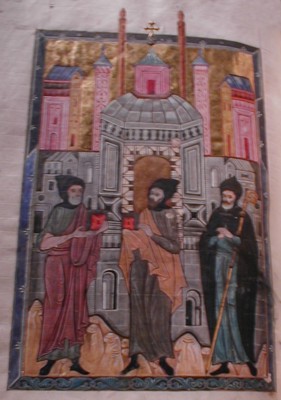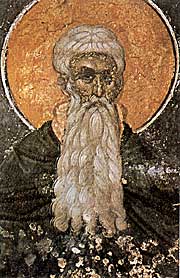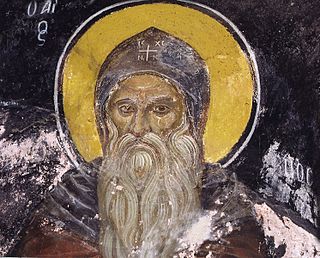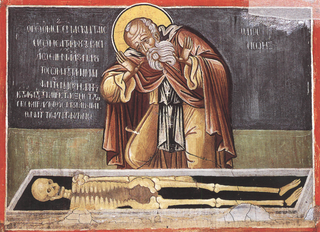Related Research Articles

Anthony the Great was a Christian monk from Egypt, revered since his death as a saint. He is distinguished from other saints named Anthony, such as Anthony of Padua, by various epithets: Anthony of Egypt, Anthony the Abbot, Anthony of the Desert, Anthony the Anchorite, Anthony the Hermit, and Anthony of Thebes. For his importance among the Desert Fathers and to all later Christian monasticism, he is also known as the Father of All Monks. His feast day is celebrated on 17 January among the Eastern Orthodox and Catholic churches and on Tobi 22 in the Coptic calendar.

Moses the Black, also known as Moses the Strong, Moses the Robber, and Moses the Ethiopian, was an ascetic monk and priest in Egypt in the fourth century AD, and a Desert Father. He is highly venerated in the Eastern Orthodox Church and the Oriental Orthodox Church. According to stories about him, he converted from a life of crime to one of asceticism. He is mentioned in Sozomen's Ecclesiastical History, written about 70 years after Moses's death.

The Desert Fathers were early Christian hermits and ascetics, who lived primarily in the Scetes desert of the Roman province of Egypt, beginning around the third century AD. The Apophthegmata Patrum is a collection of the wisdom of some of the early desert monks and nuns, in print as Sayings of the Desert Fathers. The first Desert Father was Paul of Thebes, and the most well known was Anthony the Great, who moved to the desert in AD 270–271 and became known as both the father and founder of desert monasticism. By the time Anthony had died in AD 356, thousands of monks and nuns had been drawn to living in the desert following Anthony's example, leading his biographer, Athanasius of Alexandria, to write that "the desert had become a city." The Desert Fathers had a major influence on the development of Christianity.

Evagrius Ponticus, also called Evagrius the Solitary, was a Christian monk and ascetic from Heraclea, a city on the coast of Bithynia in Asia Minor. One of the most influential theologians in the late fourth-century church, he was well known as a thinker, polished speaker, and gifted writer. He left a promising ecclesiastical career in Constantinople and traveled to Jerusalem, where in 383 AD he became a monk at the monastery of Rufinus and Melania the Elder. He then went to Egypt and spent the remaining years of his life in Nitria and Kellia, marked by years of asceticism and writing. He was a disciple of several influential contemporary church leaders, including Basil of Caesarea, Gregory of Nazianzus, and Macarius of Egypt. He was a teacher of others, including John Cassian and Palladius of Galatia.
Samuel the Confessor is a Coptic Orthodox saint, venerated in all Oriental Orthodox Churches. He is most famous for his torture at the hands of the Chalcedonian Byzantines, for his witness of the Arab invasion of Egypt, and for having built the monastery that carries his name in Mount Qalamoun. He carries the label "confessor" because he endured torture for his Christian faith, but was not a martyr.

Arsenius the Deacon, sometimes known as Arsenius of Scetis and Turah, Arsenius the Roman or Arsenius the Great, was a Roman imperial tutor who became an anchorite in Egypt, one of the most highly regarded of the Desert Fathers, whose teachings were greatly influential on the development of asceticism and the contemplative life.

Pambo was a Coptic Desert Father of the fourth century and disciple of Anthony the Great. His feast day is July 18 among the Oriental Orthodox, Eastern Orthodox, and Catholic churches.
Abib and Apollo were two Christian ascetics from Akhmim, Egypt. They are mentioned in the Synaxarion, das ist der Heiligen-Kalendar der Koptischen Christen. Their feast day is celebrated on November 4.

The Lausiac History is a seminal work archiving the Desert Fathers written in 419–420 AD by Palladius of Galatia, at the request of Lausus, chamberlain at the court of the Byzantine Emperor Theodosius II.

The Sayings of the Desert Fathers is the name given to various textual collections consisting of stories and sayings attributed to the Desert Fathers and Desert Mothers from approximately the 5th century AD.

Abba Poemen the Great was a Christian monk and early Desert Father who is the most quoted Abba (Father) in the Apophthegmata Patrum. Abba Poemen was quoted most often for his gift as a spiritual guide, reflected in the name "Poemen" ("Shepherd"), rather than for his asceticism. He is considered a saint in Eastern Christianity. His feast day is August 27 in the Julian calendar.
Nitria is one of the earliest Christian monastic sites in Egypt and is located in the Nitrian Desert. It was the first of the three major centers of Christian monastic activity in the Lower Egypt, the other two being Kellia and Scetis.
The Asceticon by Abba Isaiah of Scetis is a diverse anthology of essays by an Egyptian Christian monk who left Scetis around 450 AD.

Saint Sisoës the Great was an early Christian desert father, a solitary monk pursuing asceticism in the Egyptian desert in a cave of his predecessor, St Anthony the Great. St Sisoës is revered as a saint by the Roman Catholic Church and the Eastern Orthodox Church, who consider him a wonderworker. His feast day is observed on July 19 [O.S. July 6].
Abba Agathon was an Egyptian Orthodox Christian monk and saint who lived around the 4th century in Scetis, Lower Egypt and was known for his meekness and discernment. He was a disciple of Abba Lot and Abba Poemen and a contemporary of notable Desert Fathers Amun, Macarius, Joseph and Peter. He is venerated as a saint in the Orthodox Church on March 2. Agathon was one of the Desert Fathers.
AbbaLot was an Egyptian Orthodox Christian monk and saint who lived around the 4th and 5th centuries in a monastery near Arsinoe (Al-Fayoum), lower Egypt, by a marshy lake. Abba Lot "...directed many brethren on the path to salvation." He was one of the Desert Fathers.
Ammonas of Egypt was an eastern Christian anchorite, monastic, and Desert Father who was born around the early 4th century. He is a saint in the Eastern Orthodox Church. Ammonas was a disciple of Anthony the Great and Pambo. Many of his known sayings and quotations exist in eleven sections of the Sayings of the Desert Fathers.
Serapion of Nitria, Serapion of Thmuis, also spelled Sarapion, or Serapion the Scholastic was an early Christian monk and bishop of Thmuis in Lower Egypt, born in the 4th century. He is notable for fighting alongside Athanasius of Alexandria against Arianism.
Mount Colzim, also known as the Inner Mountain of Saint Anthony, is a mountain in Red Sea Governorate, Egypt. It was the final residency of Anthony the Great from about AD 311, when he was 62 years of age, to his death in 356.
Abba Pitirim of Porphyry or Pitirim of Egypt was an Egyptian Christian monastic and saint of the fourth century, and a disciple of Anthony the Great. His feast day is November 29 in the Orthodox Church.
References
- 1 2 3 4 5 6 "Vitae Patrum". www.vitae-patrum.org.uk. Retrieved 2022-05-03.
- 1 2 3 4 5 6 7 8 9 10 11 Velimirović, Nikolaj. The prologue of Ohrid : lives of saints, hymns, reflections and homilies for every day of the year. OCLC 944525984.
- ↑ "Abba Or". Pitts Digital Image Archive. Emory University. Retrieved 2021-11-15.
- 1 2 3 4 5 6 7 8 9 10 "Abba Or". Wind Ministries. 2017-02-13. Retrieved 2021-11-15.
- 1 2 "Lower Than Every Man". Killing the Buddha. 2015-07-20. Retrieved 2022-03-24.
- 1 2 3 4 5 6 7 Ward, Benedicta (1984). The sayings of the Desert Fathers: the alphabetical collection. Kalamazoo, MI: Cistercian Publications. ISBN 0-87907-959-2.
- 1 2 3 4 5 6 7 8 9 10 11 12 13 14 15 16 17 18 19 20 21 22 23 24 25 26 27 28 29 "Life and Sayings of Holy Abba Or of Nitria". Orthodox Christianity Then and Now. 2004-02-27. Retrieved 2021-11-15.
- ↑ "How the Desert Fathers Can Lead Us Back to the Heart of Christ". Catholic Exchange. 2018-03-29. Retrieved 2022-03-24.
- ↑ "Sayings and Stories from the Desert Fathers". Benedictine Abbey of Christ in the Desert. Retrieved 2022-03-24.
- ↑ "The Ancient Fathers of the Desert: Section 7 - Theology - Greek Orthodox Archdiocese of America". www.goarch.org. Retrieved 2022-03-24.
- ↑ "Palladius, The Lausiac History (1918) pp.1-34. Introduction". www.tertullian.org. Retrieved 2022-03-24.